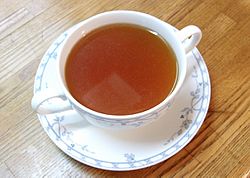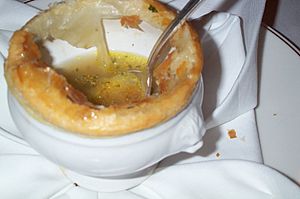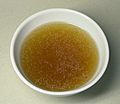Consommé facts for kids

Poultry consommé
|
|
| Type | Soup |
|---|---|
| Place of origin | France |
| Main ingredients | Stock or bouillon, ground meat, mirepoix (carrots, celery, leek), tomatoes, egg whites |
A consommé is a special kind of clear soup. It's made from a very tasty stock or broth that has been made super clear. This clearing process uses egg whites to take out any fat or tiny bits that make the soup cloudy. It's like magic, turning a regular broth into a sparkling, flavorful liquid!
Contents
Making and Serving Consommé
Making a consommé starts by adding a mix of ground meat, along with chopped vegetables called mirepoix. Mirepoix usually includes carrots, celery, and leek. Tomatoes and egg whites are also added to the broth or stock.
The secret to a great consommé is to simmer it gently. Simmering means cooking it just below boiling. As it simmers and you stir it often, tiny bits that make the soup cloudy come to the top. The acid from the tomatoes helps pull these bits out even more.
Eventually, the solid parts, especially from the egg whites, start to stick together on the surface. This forms a thick layer called a 'raft'. Once this 'raft' appears, the heat is turned down. The consommé then simmers slowly for about 45 minutes to over an hour. This helps it get the perfect rich flavor.
The finished consommé is a clear liquid. It can be a deep amber color if made from beef or veal, or a very pale yellow if made from chicken. After cooking, it's carefully poured out and filtered again. This makes sure it's super pure. Then, all the visible fat is carefully skimmed off the top.
To get rid of every last bit of fat, the consommé can be put in the fridge. The cold makes any remaining fat rise to the top, where it can be easily removed. Another trick is to drag strips of parchment paper across the surface. The tiny fat drops stick to the paper, leaving the consommé perfectly clear.
For the best flavor and feel, it's good to leave cartilage and tendons on the meat. They contain gelatin, which makes the soup feel richer in your mouth. If you use beef or veal, meat from the shin is great. It has little fat and lots of gristle, which is perfect for consommé flavor. The meat should be ground very finely, almost like a paste.
Consommés are usually served very hot. This is because they cool down quickly and can start to turn into a gel. They are often served with small additions, called garnishes. These can be simple, like a splash of sherry wine or an egg yolk. Or they can be fancy, like tiny cut vegetables or savory custards called 'royales'.
Making consommé uses a lot of meat for a small amount of soup. For example, 500 grams (about one pound) of meat might only make 250 milliliters (about 8 ounces) of consommé!
Different Kinds of Consommé

There are a few different types of consommé you might find:
- Double Consommé: This is a super-strong consommé. You can make it by using twice the amount of meat in the recipe. Another way is to make a normal consommé and then cook it down until it's half its original amount. Or, you can make a consommé using already-made consommé instead of water! Double consommé is often used in cold dishes, especially those with aspic, which is a savory jelly.
- Chilled or Jellied Consommé: This type is served cold. It becomes thick naturally because of the gelatin that comes out of the bones when the original stock is made. This gelatin gives the consommé a jelly-like texture when it cools down. Sometimes, extra gelatin is added to make sure it sets perfectly.
Gelatin-Filtered Broths
In recent years, chefs have found a new way to make broths clear using gelatin and freezing. This method is different from traditional consommé.
Here's how it works:
- First, you freeze a broth that contains gelatin. When water freezes, it forms ice crystals. But the water connected to things like gelatin, fat, and flavor stays unfrozen, even at very cold temperatures.
- Then, you let the frozen broth slowly thaw in a mesh strainer, keeping it just above freezing.
- As the ice melts, the gelatin and other flavors are trapped in a stable network, like a filter. This filter catches larger bits of fat or protein.
- The clear, melted water and small flavor parts pass through the gelatin filter and the strainer into a bowl below.
- Because it thaws slowly and stays cold, the water doesn't dissolve the gelatin filter. What's left in the strainer is the gelatin network with the cloudy bits. The clear liquid collected is your clarified broth!
This method is less wasteful than traditional consommé because you don't throw away the 'raft' of egg whites and meat. It can also be used to clarify things that can't be heated, like fruit juices. You just add a little gelatin to the juice, then use this freezing method. Chefs have even made "pretzel consommé" and "spiced pumpkin consommé" this way!
However, gelatin-filtered broths don't have the same rich feel in your mouth as traditional consommé. This is because the gelatin is removed. Also, a traditional consommé turns into a jelly when chilled, but a gelatin-filtered one does not.
History of Consommé
Clear broths like consommé have been around since the Middle Ages. They came in many forms, from simple soups to those made from unusual animals.
Interestingly, there was a special type of consommé made only with tendons and cartilage, without salt. This was sweetened, flavored with fruits, and served as a dessert! These sweet consommé creations were actually early versions of the gelatin desserts we enjoy today.
Images for kids
See also
 In Spanish: Consomé para niños
In Spanish: Consomé para niños


